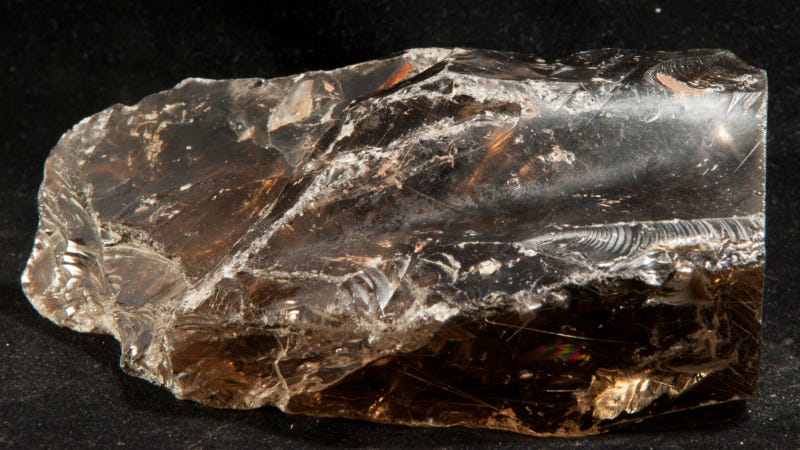
Posted on 09/10/2015 2:06:19 PM PDT by Gamecock
p class="first-text" data-textannotation-id="87e8f54959434042c67291d39538e085">Removing unwanted body hair has been a part of human hygiene since the dawn of history. Over the centuries, this practice has served to denote everything from high-ranking social status to acts of contrition. And as the tradition of shaving has evolved in step with global culture, so too have the tools of the trade.

Flaked obsidian was equally useful as a hand ax and shaving stone. Image: farbled
While our early ancestors are routinely depicted as scraggly vagabonds, in the unending winter of our last Ice Age, facial hair was a liability. Once wet, it would hold water against the skin until frozen, accelerating the onset of frostbite. To remove the dangerous stubble, early humans are believed to have begun pulling out their hairs about 100,ooo years ago—mainly using seashells like tweezers, based on cave paintings depictions. 60,000 years later, the technique had advanced from plucking to actually shaving using flakes of obsidian and clam shell shards.
The first depilatory creams—rendered from arsenic, quicklime, and starch—made their first appearance around 3000 BC, and were employed primarily by women. At the same time, the new agricultural revolution allowed for the development of settlements, metalworking, and consequently, metal blades.
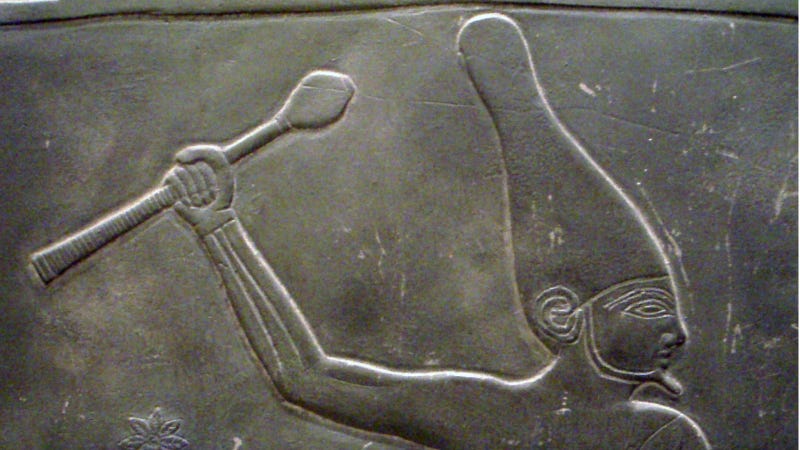
Egyptian King Narmer wearing the White Crown and a false beard Image: Keith Schengili-Roberts - Royal Ontario Museum
In the fourth century BC, Greek historian Herodotus (485-425BC) derisively noted that the Egyptians "set cleanliness above seemliness" by bathing several times daily and maintaining a strict regimen of shaving their bodies clean—men, women, even children. Everybody, especially the upper classes, went completely bare. And for good reason.
Egypt is insanely hot—and living along the muggy shores of Nile River with shoulder length hair is intolerable. What's more, long hair can house pests and diseases alike (looking at you, head lice). And given the general lack of effective medicine available to the majority of the public—or soap, for that matter—going bald was a much safer and more hygienic alternative. This early health advantage eventually evolved into the mark of the "superior" Egyptian civilization, wherein only barbarians, peasants, slaves, mercenaries, and criminals sported hair.
To achieve this hairless state, Egyptians routinely applied depilatory creams and repeated rubbings with a pumice stone to remove every trace of stubble. Archaeologists have also found both circular bronze razors and hatched-shaped "rotary" blades in many burial chambers, for use in the afterlife.
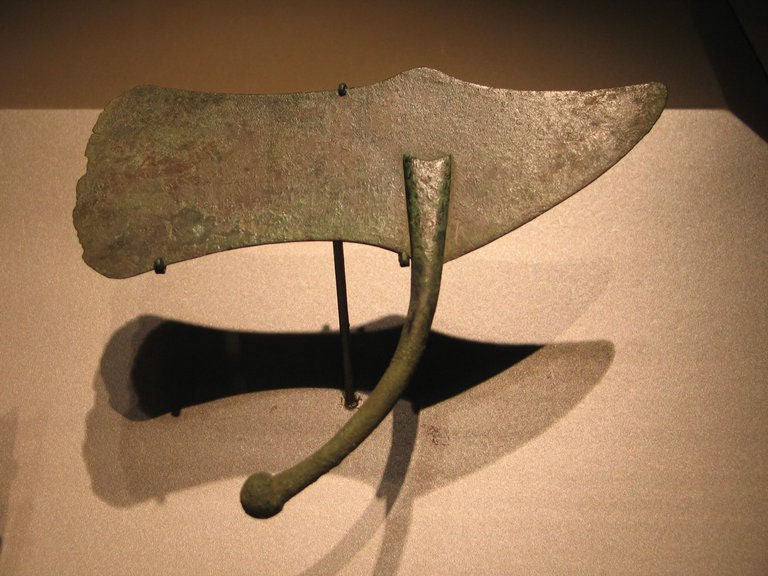
an Egyptian rotary razor - image: Brooklyn Museum
To protect their superior chrome domes from the intense rays of the desert sun, the Egyptians wore wigs designed to maximize airflow over the scalp while defending against harmful rays. Going bald in public, however, was still seen as a social faux pas.
Similarly, growing facial hair was viewed as a sign of personal neglect—like wearing the same outfit to the office three days in a row. As such, anybody who could afford the luxury hired a household barber to keep everybody tidy. The position of barber was a well-regarded station in that society, comparable to doctors and other professional trades. Now, that doesn't mean that the Egyptians didn't still regard a man with a full beard as more masculine than a clean shaven one—they absolutely did. But as with the hair on their heads, Egyptians preferred false beards if they were to wear hair on their faces. This is why every Pharaoh, even the female ones, are depicted wearing false beards in the hieroglyphic record.

"Alexander fighting king Darius III of Persia" - Naples National Archaeological Museum
Not everybody was as unimpressed by the Egyptians' fanatical hygiene as Herodotus. And by the fourth century BC, the practice had made its way north to Greece and Rome—thanks in no small part to Alexander the Great's order that his troops shave off their locks. This gave the enemy nothing to grab onto during hand to hand combat.
Alexander's tacit endorsement of shaving immediately made it not only socially acceptable, but fashionable as well. In the years to follow, the original circular razor design pioneered by the Egyptians was straightened into a form very close to the razors still used today. The quality of the construction also improved, replacing easily dulled bronze with copper and iron.
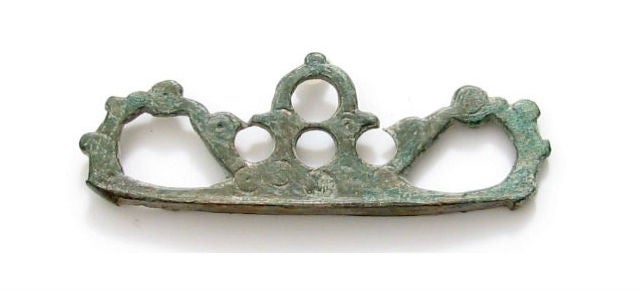
The lower edge of a novacila, such as this, would hold a thin metal blade - image: Beholding Glory
After the requisite swipes of the razor blade, known as a novacila, Romans would then rub the stubble off with pumice stones, and massage oils and perfumes into the skin. Nicks from a dull razor would be treated with a plaster ointment made from spider webs soaked in oil and vinegar.
The trend in shaving was initially spurred by Alexander's celebrity endorsement, but it quickly became an integral part of Roman society. Barbershops, or "tonsors," were not just a service but also a local meeting place where the day's gossip and news could be freely exchanged. This was only among the classes that could afford it, of course, and if you were rich enough, you'd have a household barber. The richer you were, the less body hair you sported—yes, even pubic hair.

Image: Castres, bibliothèque municipale
The practice of shaving saw a slight decline during the Middle Ages, though it remained popular, even if for an entirely different set of reasons from the Romans. See, after the Catholic church split from the Eastern Orthodox in 1054, Western church leaders encouraged shaving among its clergy to distinguish its members from the their Jewish and Muslim counterparts. That trend was put into canonical law in 1096, when the Archbishop of Rouen banned beards outright save for Crusaders in the Holy Land.

Queen Elizabeth in her coronation robes
Shaving, similarly, remained popular among women in the Middle Ages, who followed the example of Queen Elizabeth I. She started the trend of tweezing the eyebrows (or applying a walnut oil, vinegar, and ammonia concoction) to elongate the forehead, but left everything below the neck au naturale.
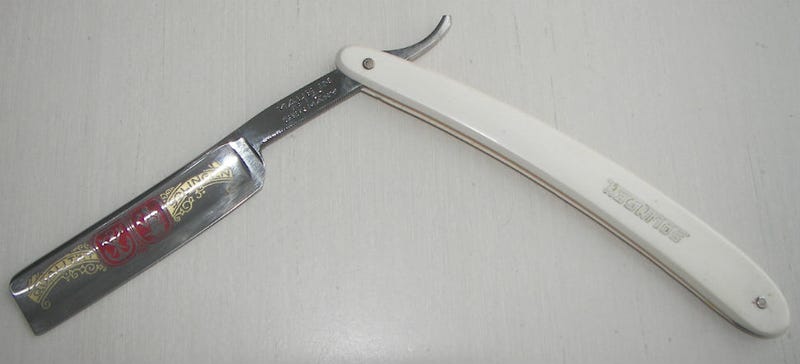
A straight razor - image: Dr.K
It wasn't until the late 18th century that razors became more than sharp, exposed slabs of metal. Up until then, they were still regarded as specialized professional tools and everybody still went to barbers. Men of the day would shave themselves just as soon as they'd lay their own brick garden wall—it simply didn't happen.
However, French inventor Jean-Jacques Perret dared to dream of a world where men would spend each morning leaning over a bathroom mirror removing their own stubble, and to that end, Perret developed the world's first safety razor—by installing a wooden guard onto a standard straight razor.

The Kampfe Brothers Star Razor Blade Kit - Image: HerrHepcat, Badger and Blade
This design evolved again, in the early 19th century, into the modern Sheffield straight razor, featuring a rotating guard the doubled as a handle. Then, in 1880, the Kampfe brothers patented and marketed the world's first safety razor, incorporating a wire guard along the edge of the blade as well as a lather-catching head.

The problem with the Kampfe brothers' safety razor was the fact the head had to be routinely removed from the handle and sharpened on a whet stone. But rather than go through the trouble of sharpening that head, why not just replace it with a new one? That was the idea concocted by a traveling salesman by the name of King C. Gillette in 1895. And it would soon prove to be a money-making bonanza—just as soon as Gillette could figure out how to make a thin, sharp, disposable blade cheaply enough to work.
It took Gillette another eight years and the help of MIT professor William Nickerson to develop the first modern, double-edged safety razor. By 1906, Gillette was selling more than 300,000 razors a year, and a US Army contract supplying every WWI American soldier with a Gillette safety razor in his DOP kit helped further cement the Gillette brand name in the annals of American history.
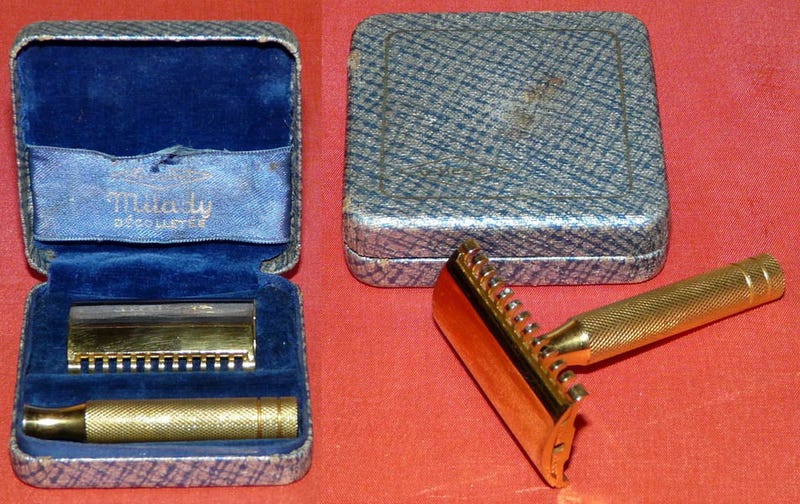
The Milady Decolletée - image: Mr Razor
By the middle of the next decade, Gillette was more than a household name, it was a ubiquitous brand found in bathroom cabinets across the country. But still only for the gents.
However, rapidly changing social mores of the time saw women exposing more skin above the ankle and wrist—a leading fashion magazine of the time went so far as to show a woman in a swimming suit with her arms raised and armpits bare. Until that point, depilatory cremes were the defacto method of ladies hair removal. That changed in 1915, when Gillette debuted the Milady Decolletée, the first razor built specifically for women.

The Milady Decolletée instruction manual - image: Mr Razor
Being a primarily manual razor manufacturer, Gillette wasn't involved with the advent of the electric razor in the 1920s (which we'll get to in a second) and didn't really see any major technological breakthroughs until 1960, when its engineers perfected production of stainless steel blades. Unlike older blades, which would rust almost immediately after their first use, these blades remained sharp and oxide-free for multiple uses. This directly influenced the invention of the first fully disposable razor—where the entire device, handle and all, could be thrown away once dulled.
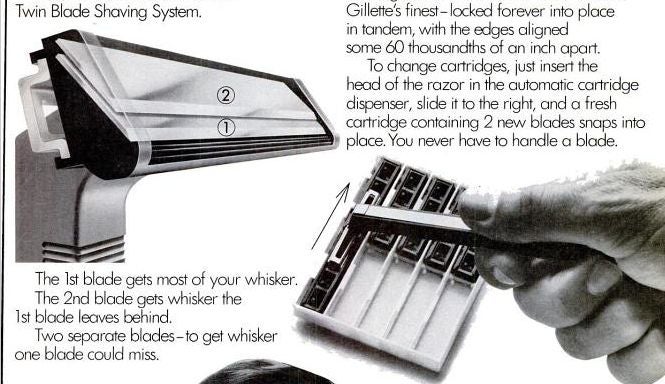
A two-page advertisement in Life Magazine Dec 10, 1971 image: Off the Top
Gillette once again revolutionized shaving in 1971, with its debut of the first two-blade razor, the Trac II. The multi-blade approach reduced the amount of force that had to be applied to shave—which in turn reduced the amount of irritation the skin endured—and has proven so popular that the number of blades per head has exploded from three blades, to five, to seven or more.
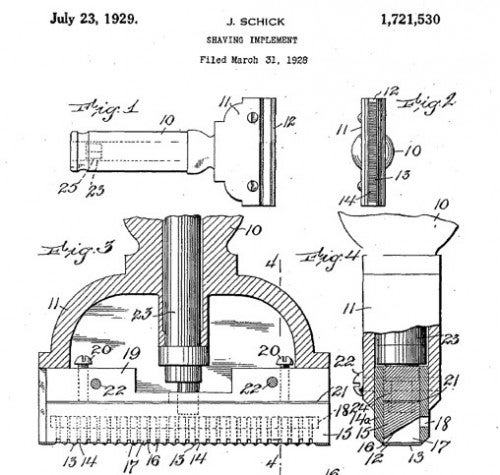
As electricity in the American home became more common at the turn of the 20th century, the razor—like many previously manual devices—grew a corded tail and mechanical guts. The initial entries into the electric razor market, however, were met with only limited success. Electric razors wouldn't come into their own until 1928, when a retired Army colonel named Jacob Schick patented his own design—consisting of a cutting head driven by a handheld motor, connected by a flexible rotating shaft.
This model, which went on sale in 1929 (just in time for the stock market crash!), did not sell well—both because of the sudden crushing poverty that engulfed the nation and its unwieldy design. Schick's second attempt dropped the flexible shaft and instead plopped a smaller motor inline behind the cutting head, consolidating the clumsy motor and hose setup into a single sleek device. It was the iPod of its day, retailing for $25 each ($350 in today's money), and moving 3,000 units the first year. By 1937, Schick had sold 1.5 million of them and cracked open the new $20 million "dry shave" market.

The Lady Schick - Image: Saturday Evening Post advertisement
In 1940, at the start of WWII, Remington opened the dry shave market further by designing and selling the first women's electric razor. Since nylon was a valuable wartime commodity, women were forced to go bare legged more often—and Remington's razor was billed as an easier, cheaper, and faster alternative to manual shaving.
Since the 1940s, hair removal technology has continued to advance. Waxing strips and laser hair removal methods both debuted in the mid-1960s, though laser's tendency to singe the skin as well as the hair quickly led to its disuse in favor of electrolysis, wherein a very fine heat probe is used to destroy a hair follicle, after which the hair itself is tweezed out.
These days, electric razors come in a huge variety shapes and sizes—from little finger-sized nosehair trimmers to vacuum-powered Flowbees—depending on their application. Though, just as with manual multi-blade razors, electric razors with multiple cutting heads are now more rule than exception.
They're just as often powered by rechargeable Li-ion batteries packs rather than wall cords, and use swiveling, rotating cutting heads as they employ the linear cutter devised by Schick nearly a century before. The problem now? Picking the best one.
Some group or other ping.
Whatever you do, don't use ear hair!

And Michael Jackson.
And Richard Pryor.
Edwin Jagger "Chatsworth" Ivory
Feathers (Medical Blades from Japan - sharpest blade in the world)
Various Italian soaps and my favorite, Van Der Hagen



I bought a nice safety razor from The Art of Shaving store a couple of months ago... thought I could save a bit of money, on those blades... but I had far too many accidents with it... I’m back to my Gillette Fusion.. I do plan on trying Harry’s and also the Dollar Shave Club.
Interesting...I am completely the other way, and as I got older, I cut my hair shorter and shorter until I was sporting a high and tight cut shaved high up the sides, but...my hair growth is completely spotty (looks like a moth has chewed on my hair)
I couldn’t get the high and tight to look good, and it started to look more and more like a mohawk and less like a high and tight. My wife started trying to help by using clippers to try to grade it, but I had a big oval spot (about two inches) on the side of my head where I injured my head and the hair doesn’t grow.
Finally, last month, I just said the Hell with it, and now shave my head completely, which I really like. LOL, some folks don’t know how to take it, but...in my view, it is just hair. I can grow it back.
It makes shaving a far more interesting task in the morning now. I shave in the shower, and completely cover my head and face with shaving cream, and it takes about 12 minutes for me to complete shaving. I had been doing it for about two weeks, and cut my head behind my left ear so badly it took about three weeks to heal. I learned a lesson there...you have to be deliberate
I enjoy shaving, because for years, I couldn’t shave. I have scars on my face from when I was in the Navy, and they made me shave every day, and I got those ingrown hairs which are really, really nasty. I took to using a depilatory paste that a lot of black guys used, but I hated that stuff because it smelled just god-awful, and you could burn your face with it. When I got out, I had two cases of it that I brought home with me and used it for a few years until I simply stopped trying to shave every day.
I hated having a beard, just didn’t feel good on me, so for about 25 years I had a continual three days growth before it became “fashionable”...:)
Back around 2005, the head of our department was a woman who had been a colonel in the US Army, and she stopped me in the hall and asked my why I didn’t shave.
I explained it to her, and she said simply: “Use antibacterial soap on your face.” That was it. I did wash my face before shaving, but...it didn’t help. Once I started using Dial liquid soap, I was able to shave every day after that, and wondered why nobody had ever told me that. (She was a physician)
I know some people hate it, but I love the way it feels every morning to be completely clean and fresh.
Now, I realize I am starting to get Scottish eyebrows and hair in my ears, damnit!
See my post...try using Dial liquid antibacterial soap on your face...it worked for me after suffering for most of my life with shaving nastiness...
very interesting. Thanks for posting.
Thanks for the info!
I’ve used both. I like the canned goo. But then, I also liked Ivory soap better than the “Shaving soaps”. I hated Proraso. But I also like a 5 minute shave, 6 at the upper limit. Wipe down with 70% isopropyl alcohol, then a little skin lotion and go.
If I’m really in a hurry, the Trac 2 does a decent job fast. The Mach 3 was no improvement. I tried a 5-bladed thing a year ago...felt like I was buffing my skin with 60 grit sandpaper. I don’t understand how anyone can use them, but lots of folks don’t understand why I like canned goo...
;>)
I might watch Duck Dynasty if they would shave their beards off.
I have tried the single blade razor of yesteryear and Taylors shaving cream. You get a very close shave but if you are not really careful you also get razor burn!.
Best blades are Gillette Fusion ProGlide. They last up to a month if you wash them clean after use and dry the blade everyday. Buy them at Amazon to save money over supermarket prices.
http://www.amazon.com/Gillette-Fusion-ProGlide-Manual-Refills/dp/B003983HZK
Gillette Fusion Hydra Gel Ultra Sensitive Shave Gel. Use this with the blades above. Buy at supermarket. A little goes a long way.
http://tinyurl.com/po48d8v
Or use an AXE
https://www.youtube.com/watch?v=_NN3fWyIDk4
In Egypt, shaving also had religious significance. For example, no one was allowed to enter the magnificent temple at Karnak unless they were completely shaved, and kept completely shaved.
So you figure the regular complement of workers and priests there, perhaps a thousand or more, as well at the peak time during which the Pharoah was obligated to visit, along with his entourage, they must have had large numbers of barbers working overtime.
In that the Pharoah had so many servants that one in particular was titled “guardian of the anus”, and his sole purpose was to administer the royal enema, you figure that he spent a heck of a lot of time “getting his hair done.”
Those Feather Blades are sharp enough to split an atom!
Tell me about the Van Der Hagen. What do you like about it?
The Feathers fit the EJ Chatsworth perfectly - no pressure required as the head is perfectly balanced.
Re: soaps, I’ve tried many of the Italian brands via “ItalianBarber.com”.
A few weeks ago I was running low and just picked up the 3.5oz VdH at Krogers for $4.50. With the Feathers, I get both a SUPER close shave with absolute no irritation.
I do like to soak it in hot water while I shower and, before shaving slap some of the soapy liquid on my face to pre-condition before applying the foam with my brush.
“Nick Shaves” has videos on his YouTube channel and gave a very positive review of the “basic” version of VdH using Feathers. I haven’t tried that version, though.
https://www.youtube.com/watch?v=zHg9MryNdT0
If you can get past the learning curve, there's nothing even close to a Feather Artists Club straight razor with disposable blades. No pull, no burn, no ingrown hairs. Smooth as a baby's bottom: literally.
I use the preshave oil and cream from Art of Shaving. It's more expensive, but worth every penny. Besides, it's never a good idea to cheap out on something you use every day.
I switched from the money sucking disposable razors to wet shaving about 2 years ago. What a freakin’ difference! Grandpa had it right all this time. Now I use a Merkur heavy classic 34c, Vulfix 2235s brush, and Taylor of Old Bond Street shaving cream. I wish I had discovered this decades ago.
I use that same razor with Feather blades and Proraso shaving cream. I was amazed at the difference. Nothing I’ve ever used comes close to the quality of that shave and the Merkur razor is quality that will outlast me! Considering trying the Taylor of Old Bond Street.
Disclaimer: Opinions posted on Free Republic are those of the individual posters and do not necessarily represent the opinion of Free Republic or its management. All materials posted herein are protected by copyright law and the exemption for fair use of copyrighted works.